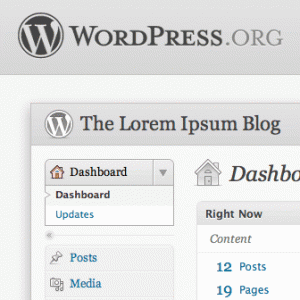위키소프트는 2008년 이후 지속적으로 WordPress 개발 사업을 운영하여 국내 최고 수준의 기술력을 보유하고 있으며, 타시스템과의 연동을 비롯하여 최근에는 SNS 서비스 연계를 통한 서비스 확대로 사업범위를 넓히고 있습니다.
워드 프레스는 웹 표준 및 가용성에 중점을두고 오픈소스로 개발된 국제적 개인 출판 플랫폼입니다.
최초 블로그시스템으로 출발하였으나, 꾸준한 기능발전과 편리성, 확장성을 통해 최근에는 훌륭한 컨텐츠 컨테이너로서 활용되고 있습니다.
Key features of “WordPress”:
- Full standards compliance — We have gone to great lengths to make sure every bit of WordPress generated code is in full compliance with the standards of the W3C. This is important not only for interoperability with today’s browser but also for forward compatibility with the tools of the next generation. Your web site is a beautiful thing, and you should demand nothing less.
- No rebuilding — Changes you make to your templates or entries are reflected immediately on your site, with no need for regenerating static pages.
- WordPress Pages — Pages allow you to manage non-blog content easily, so for example you could have a static “About” page that you manage through WordPress. For an idea of how powerful this is, the entire WordPress.org site could be run off WordPress alone. (We don’t for technical mirroring reasons.)
- WordPress Links — Links allows you to create, maintain, and update any number of blogrolls through your administration interface. This is much faster than calling an external blogroll manager.
- WordPress Themes — WordPress comes with a full theme system which makes designing everything from the simplest blog to the most complicated webzine a piece of cake, and you can even have multiple themes with totally different looks that you switch with a single click. Have a new design every day.
- Cross-blog communication tools— WordPress fully supports both the Trackback and Pingback standards, and we are committed to supporting future standards as they develop.
- Comments — Visitors to your site can leave comments on individual entries, and through Trackback or Pingback can comment on their own site. You can enable or disable comments on a per-post basis.
- Spam protection — Out of the box WordPress comes with very robust tools such as an integrated blacklist and open proxy checker to manage and eliminate comment spam on your blog, and there is also a rich array of plugins that can take this functionality a step further.
- Full user registration — WordPress has a built-in user registration system that (if you choose) can allow people to register and maintain profiles and leave authenticated comments on your blog. You can optionally close comments for non-registered users. There are also plugins that hide posts from lower level users.
- Password Protected Posts — You can give passwords to individual posts to hide them from the public. You can also have private posts which are viewable only by their author.
- Easy Importing — We currently have importers for Movable Type, Textpattern, Greymatter, Blogger, and b2. Work on importers for Nucleus and pMachine are under way.
- XML-RPC interface — WordPress currently supports an extended version of the Blogger API, MetaWeblog API, and finally the MovableType API. You can even use clients designed for other platforms like Zempt.
- Workflow — You can have types of users that can only post drafts, not publish to the front page.
- Multiple authors — WordPress’ highly advanced user system allows up to 10 levels of users, with different levels having different (and configurable) privileges with regard to publishing, editing, options, and other users.
- Bookmarklets — Cross-browser bookmarklets make it easy to publish to your blog or add links to your blogroll with a minimum of effort.
- Ping away — WordPress supports pinging Ping-O-Matic, which means maximum exposure for your blog to search engines.

